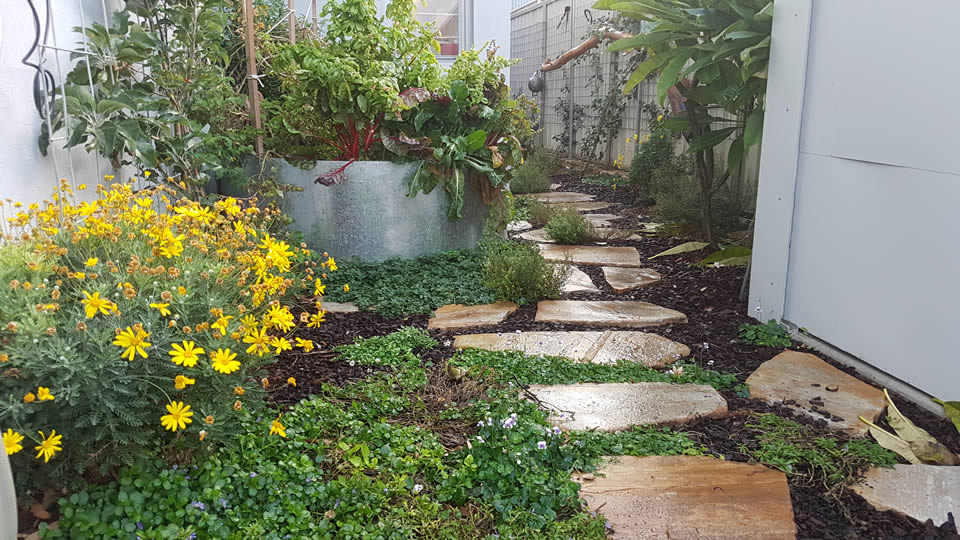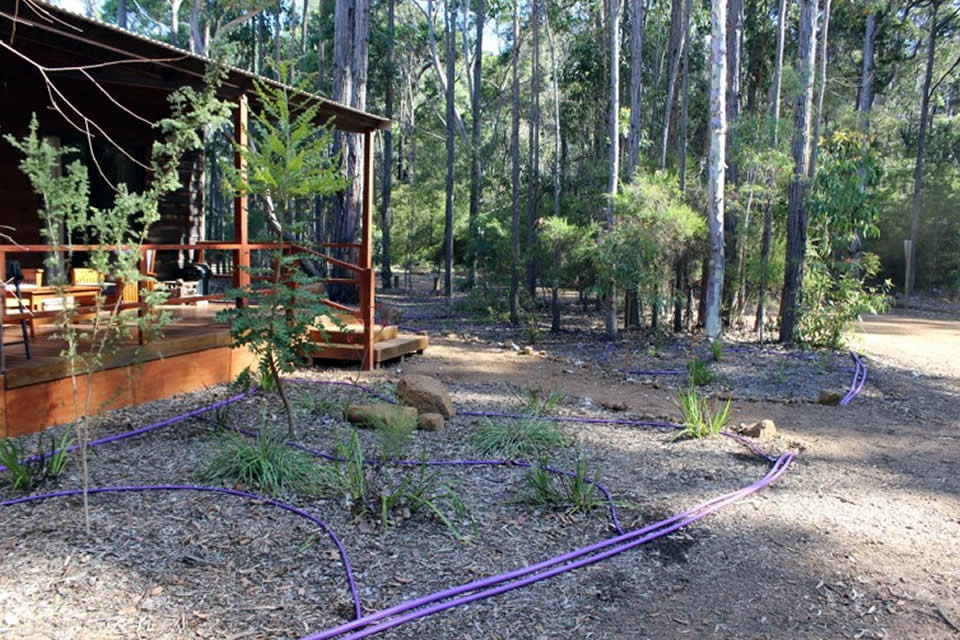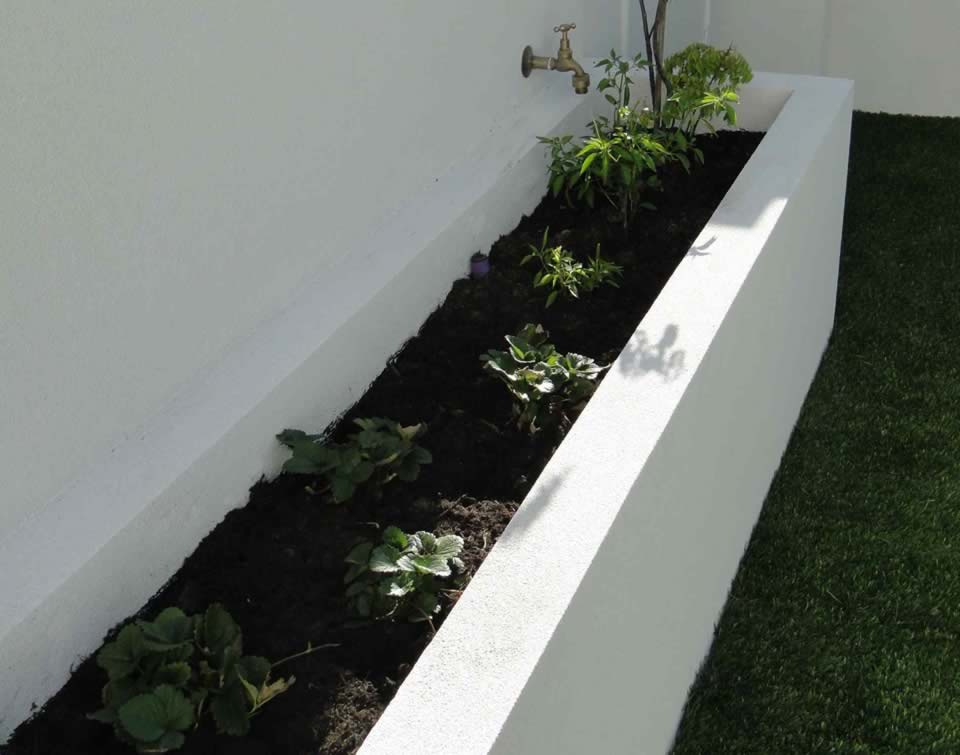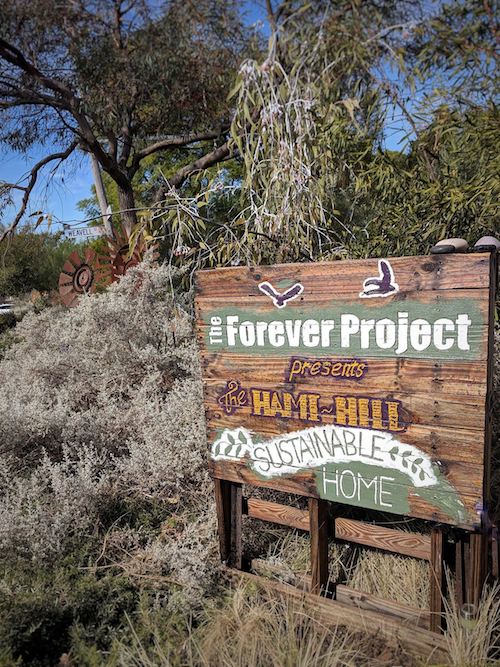Greywater for Watering Gardens
WHY NOT USE GREYWATER FOR WATERING GARDENS?
In the past two decades, Australia has experienced a net decrease in rainfall and at the same time a net increase in its population. Coupled with climate change, this has resulted in serious water shortages across the nation, and has put pressure on the limited water resources in many of the States. The long-term future of Australia, is highly dependent on how the country will manage its precious water resources.
A “fit for purpose” approach to water management, is the only proper long-term way to tackle the water crisis. The use of expensive and high energy consumption desalinated/chlorinated drinking water, to irrigate gardens and flush toilets, cannot be part of a long-term sustainable water management plan. All technological means (seawater desalination, rainwater capture, wastewater & greywater reuse) must be used if we want to effectively combat climate change.
This greywater garden thrives on 100% greywater. The Greyflow PS Self clean system with 300 watt pump was installed in a new home by Water Capture in Perth & Fremantle.
Droughts a wake-up call for all of us
The “Millennium drought” from 2001 to 2009, and currently, the “Super Drought”, are a wake-up call for Australia. We can no longer ignore the fact that our water resources need to be managed wisely.
In the past decade, the energy sector, has experienced a great upsurge in consciousness, and the use of renewables, is fast becoming common practice across the nation. It is essential that the same reality check occurs in the water sector.
Don Elder, a renown US scientist, and a hero of the 2002 US National Water Act, when focusing on global warming and energy consumption says:
“The two great global and social issues of our day, are climate change and water availability, and their solution is inseparably integrated. Only the healthiest watershed will be resilient enough to support the full range of life in the face of climate change. Saving energy, by saving water will keep coal and oil in the ground, carbon out of the air, water in our streams, and money in our pockets.”
He goes on to ascertain that, the fastest way to reduce greenhouse gas emissions is to reduce water consumption, and that the highest consumers of energy in any state, are the water service providers.
In Israel, wastewater recycling has been used for many years, and currently more than 80% of the wastewater generated in the county is reused in many applications (domestic, Agricultural, commercial & industrial).
Greywater is suitable for Australian native plants and country gardens. Our greywater system was installed by Water Wally who sells our GreyFlow units Australia wide.
Greywater reuse for gardens
Reusing the water from showers, basins, and laundries, in order to irrigate gardens, was common practice in the “olden days” right across Australia. With the development of the modern cities and the availability of inexpensive fresh water at one’s door step, Australians became complacent, and forgot how precious water is in the driest continent on earth.
It is fair to say that the “Millennium Drought”, ushered the reuse of greywater in Australia, with legislations and codes of practice being released in many of the states and territories.
As a result, many environmentally friendly soaps and detergents, have emerged on the market. They have allowed for safe and beneficial reuse of greywater in one’s backyard, as well as contributed to the rise in environmental consciousness of people.
In the past few years an Australian Standard (1546.4) for the reuse of greywater, has been developed and released.
Wastewater reuse as a means to combat desertification and grow plants is evident, and greywater reuse is considered to be the low laying fruit of wastewater recycling.
What has been learned about greywater reuse for gardens in the past 15 years
- · All domestic Greywater diversion systems should have Watermark certification.
- · The installation of a Domestic Greywater diversion should conform to the state or territory code of practice and may or may not require council approval.
- · Commercial applications can save a large amount of water, and should conform to AS 1546.4 Australian standards.
- · Domestic greywater diversion from showers, laundry & basins to gardens can be implemented in 100% of new built homes if dual plumbing is installed. Homes on stumps are also easy to retrofit, as opposed to homes on slabs which are not “Greywater ready”.
- · Greywater from Kitchen, has a high fat content and is generally not considered for reuse in gardens due to the potential negative long-term effect it can have on the soils. The use of grease traps may help to alleviate this situation.
- · All greywater diversion systems require an overflow to sewer or septic.
- · Untreated greywater becomes septic very fast and should not be stored more than 24 hours. The faster the water is diverted, the less sludge is accumulated, and the cleaner the system remains. Also, the larger the tank, the more sludge is accumulated, and more frequent desludging is required. Diversion system with small buffer tanks are preferable, as the pump out occurs while the soaps and detergents are still active, resulting in a cleaner system. They are also easier to transport, install, and are cheaper to purchase. On the other-hand greywater irrigation with small tanks can be more technically challenging specially in undulating terrain.
- · All pipes and dripline should be lilac in colour so as to help identify the reuse application. Alternatively, a purple tape with marking indicating water reuse, should be laid on top of the non-coloured pipe.
- · With installations in new homes on slabs, the 2 stage installs are recommended, and will save hundreds of dollars.
Stage 1: Installation of the system’s carcass by the plumber during the plumbing pre-lay work.
Stage 2: Installation of the pump and irrigation system when the house is completed and before the paving is laid.
- · With retrofits, Plug & Play complete diversion systems are preferable.
- · In order to extend the life of the pump, the Greywater should be filtered before it reaches the pump (pre-filtration). Post filtration, between the pump and the irrigation, can drastically reduce the life of the pump, and leads to a high maintenance system.
- · High head, closed impeller pumps are not suited for use with untreated partially filtered greywater, and should be avoided. Low head, vortex pumps can handle much larger particles and will last a lot longer in greywater diversion systems.
- · A greywater irrigation system, should be able to operate at low pressures (less than 10 m).
- · In most states and territories, only subsurface & sub-mulch drip irrigation is allowed for the dispersal of the greywater.

Zenplumb installed the GreyFlow PS greywater system for this enchanted garden in the Dandenong ranges. You can see a video of this stunning garden on our VIDEOS PAGE.
The Greyflow systems
Advanced Waste Water Systems Pty Ltd (AWWS) was registered in April 2004, in response to demand for greywater diversion created by the Millennium Drought, and has been manufacturing and selling the G-Flow and Greyflow range of greywater diversion systems.
Although, still relatively small, AWWS, sells throughout Australia and overseas (New Zealand, South Africa, Morocco, Chile, USA), has been very active in Research and Development, holds local and international patents, and has won a couple of national Awards.
The Greyflow systems have also evolved within the past 15 years and have seen the development of many models such as:
1. The Gravity G-flow above ground Greywater diversion system
2. The award winning tankless Greyflow 00 & 001 model
3. The pumped G-Flow system
4. The compact Greyflow PS model
5. The award-winning Auto-backflush filter mechanism
6. The Greyflow PRO domestic & commercial diversion systems
7. And more recently the Greyflow Clear Greywater treatment to meet AS 1546.4 level 3 & level 2.
The aim was to provide customers with systems that would:
1. Meet the Watermark Australian Standards
2. Cater for a wide range of plumbing pipe sizes, layouts & depths.
3. Be easier, safer, trouble free & cleaner to operate
4. Provide for reduced and ease of maintenance
5. Be robust and long-lasting
6. Provide for increased water recovery
7. Provide for improved water distribution efficiency
8. Consume less power

Greywater can be installed in small gardens such as this one installed by WaterCraft WA in Perth Australia.
Key product development
The traditional approach to greywater filtration has been to provide a coarse filter before the pump (pre-Filter) in order to remove the larger particles such as hair and lint, and to provide a much finer filter after the pump (post-filter) in order to remove the small particles, before the water is discharged through the sub-surface drip irrigation. This approach was adopted by most greywater manufacturers, and overtime proven to lead to early pump failure, mainly due to the lack of regular post-filtration maintenance.
AWWS and other manufacturers adopted the single fine Pre-Filtration option (no post-filtration), which has proven to be more effective in preserving the longevity of the pumps and systems. However, manual fine Pre-filtration, requires regular cleaning of the filters in order to avoid water loss to sewer. Moreover, manual cleaning of greywater system filters can be dirty, time consuming, and a burdensome task.
The key was to develop a fine pre-filter that would require very little maintenance.
Extensive research was done to find an existing automated backflush mechanism that would apply to gravity flow. Traditionally automatic backflush filters are used in pressurised applications (Post-Filtration), while gravity flow automatic filtration systems are limited to expensive mechanical devices.
So AWWS, proceeded to develop an economical, air activated (to minimise water loss), auto-backflush, gravity pre-filter. The new invention took 4 years to develop and an Australian and International patent was registered.
This auto-backflush filter mechanism could be retrofitted on older manual systems, thus allowing AWWS to offer its existing customers to convert their systems into very low maintenance diversion devices. This new development was also the key to entering the commercial market, where larger amount of water could be recycled, as well as capturing part of the growing overseas market.
Chris Ferreira at The Forever Project uses our GreyFlow PS - AG (above ground) greywater system
in his garden and sustainable home in Hamilton Hill, Fremantle.
In 2018, AWWS was presented with the 2018 Innovation for sustainable Water & Environment Outcomes Award by the WA Australian Water Association.
Greywater from shower, basins and laundry can be reused a second time to water gardens and/or flush toilets. Greywater reuse for gardens:
- · Is the first step to water recycling,
- · Helps reduce large amount of water in domestic and commercial applications,
- · Contributes to the reduction in greenhouse gas emissions,
- · Is an effective means to keep plants and trees alive during water restrictions,
- · Helps stop the advance of desertification in some regions of the world, by providing desperately needed water for tree planting,
- · Is an effective additional tool to be used for a long-term “fit for purpose” water management strategy
“Where there is a will there is a way”. Since 2004, AWWS has developed state of the art greywater diversion systems in order to enable the reuse of greywater. The first 9 years were limited to domestic applications but in the last 6 years with the development of the automated Pre-filtration, the system has proven to be very effective in commercial applications such as Caravan parks, resorts, surf-life saving clubs, retirement complex and buildings.
